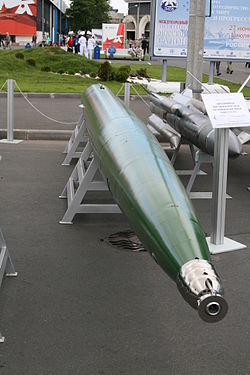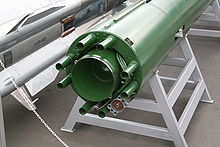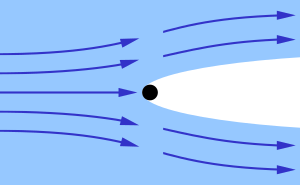From Wikipedia, the free encyclopedia
| VA-111 Shkval | |
|---|---|

VA-111 Shkval
|
|
| Type | Supercavitating Torpedo |
| Place of origin | Russia |
| Service history | |
| In service | 1977-present |
| Used by | Russian Navy |
| Production history | |
| Designer | NII-24 research institute |
| Designed | 1960s-70s |
| Manufacturer | Tactical Missiles Corporation |
| Produced | 1977-present |
| Variants | Shkval 2 Shkval-E |
| Specifications | |
| Weight | 2,700 kg (6,000 lb) |
| Length | 8.2 m (26 ft 11 in) |
| Diameter | 533 mm (21 in) |
|
|
|
| Effective firing range | Shkval: 7 km (4.3 mi) Shkval 2: From 11–15 km (6.8–9.3 mi) |
| Warhead | Conventional explosive or nuclear |
| Warhead weight | 210 kg (460 lb) |
|
|
|
| Engine | Solid-fuel rocket |
| Propellant | Solid-fuel |
| Speed | Launch speed: 50 knots (93 km/h; 58 mph) Maximum speed: in excess of 200 knots (370 km/h; 230 mph) |
|
Guidance
system |
GOLIS autonomous inertial guidance |
|
Launch
platform |
533 mm torpedo tubes |
Contents
Design and capabilities
Design began in the 1960s when the NII-24 research institute was ordered to produce a new weapon system capable of combating nuclear submarines; the Shkval being a product of this merger.Announced as being deployed in the early 1990s, although previously operational as early as 1977,[1] the Shkval is designed as a countermeasure against torpedoes launched by undetected enemy submarines. It may also be used as a counter to incoming torpedoes whereby it is launched at the enemy submarine, forcing it to evade, and hopefully cutting the guidance wire to the enemy torpedo in the process.
Shkval nose cone
Shkval rear, showing the guidance fins and the electronics connector
Launched from 533 mm torpedo tubes, the VA-111 exits the tube at 50 knots (93 km/h). Shortly afterwards, its solid-fuel rocket ignites and propels it to speeds of up to 200 knots (370 km/h). Some reports indicate that speeds of 250+ knots may be achieved, and that work on a 300-knot (560 km/h) version was underway.[2]
Early designs may have relied solely on an inertial guidance system.[3][4] The initial design was intended for nuclear warhead delivery. Later designs reportedly include terminal guidance and conventional warheads.[5]
The torpedo controls its direction using four fins that skim the inner surface of the supercavitation envelope. To change direction, the fin or fins on the inside of the desired turn are extended, and the opposing fins are retracted. To make faster turns, the push plate on the nose can be used to control the shape of the bubble the missile is traveling in.
Manufacture
The torpedo is manufactured in Kyrgyzstan by a state-owned factory. In 2012 the Russian government asked for a 75% ownership of the factory in exchange for writing off massive Kyrgyz debt to Russia.[6]Espionage
In 2000, former U.S. Naval intelligence officer and an alleged DIA spy Edmond Pope (Captain, USN, retired) was held, tried, and convicted in Russia of espionage related to information he obtained about the Shkval weapon system. Russian President Vladimir Putin pardoned Pope in December 2000, allegedly on humanitarian grounds because he had bone cancer.[7][8]Specifications
There are at least three variants:- VA-111 Shkval – Original variant; GOLIS autonomous inertial guidance.
- "Shkval 2" - Current variant; believed to have additional guidance systems, possibly via the use of vectored thrust, and with much longer range.
- A less capable version currently being exported to various third world navies. The export version is referred to as "Shkval-E".
- Iran claimed it has created a version named Hoot.
- Length: 8.2 m (26 ft 11 in)
- Diameter: 533 mm (21 in)
- Weight: 2,700 kg (6,000 lb)
- Warhead weight: 210 kg (460 lb)
- Speed
- Launch speed: 50 knots (93 km/h; 58 mph)
- Maximum speed: 200 knots (370 km/h; 230 mph) or greater
- Range: Around 11–15 km (6.8–9.3 mi) (new version). Older versions only 7 km (4.3 mi)[9]
Supercavitation
From Wikipedia, the free encyclopedia
An object (black) encounters a liquid (blue) at high speed. The fluid
pressure behind the object is lowered below the vapour pressure of the
liquid, forming a bubble of vapour (a cavity) that encompasses the
object.
Contents
Physical principle
In water, cavitation occurs when water pressure is lowered below the water's vapour pressure, forming bubbles of vapour. That can happen when water is accelerated to high speeds as when turning a sharp corner around a moving piece of metal such as a ship's propeller or a pump's impeller. The greater the water depth (or pressure for a water pipe) at which the fluid acceleration occurs, the lesser the tendency for cavitation because of the greater difference between local pressure and vapour pressure. (The non-dimensional cavitation number is a measure of the tendency for vapour pressure bubbles to form in a liquid, calculated as the difference between local pressure and vapour pressure, divided by dynamic pressure.) Once the flow slows down again, the water vapour will generally be reabsorbed into the liquid water. That can be a problem for ship propellers if cavitation bubbles implode on the surface of the propeller, each applying a small force that is concentrated in both location and time, causing damage.A common occurrence of water vapour bubbles is observed in a pan of boiling water. In that case the water pressure is not reduced, but rather, the vapour pressure of the water is increased by means of heating. If the heat source is sufficient, the bubbles will detach from the bottom of the pan and rise to the surface as steam. Otherwise if the pan is removed from the heat the bubbles will be reabsorbed into the water as it cools, possibly causing pitting or spalling on the bottom of the pan as the bubbles implode.[citation needed]
A supercavitating object is a high speed submerged object that is designed to initiate a cavitation bubble at the nose which (either naturally or augmented with internally generated gas) extends past the aft end of the object, substantially reducing the skin friction drag that would be present if the sides of the object were in contact with the liquid in which the object is submerged. A key feature of the supercavitating object is the nose, which may be shaped as a flat disk or cone, and may be articulated, but which likely has a sharp edge around the perimeter behind which the cavitation bubble forms.[1] The shape of the object aft of the nose will generally be slender in order to stay within the limited diameter of the cavitation bubble. If the bubble is of insufficient length to encompass the object, especially at slower speeds, the bubble can be enlarged and extended by injection of high pressure gas near the object's nose.[1]
The great speed required for supercavitation to work can be achieved temporarily by a projectile fired under water or by an airborne projectile impacting the water. Rocket propulsion can be used for sustained operation, with the possibility of tapping high pressure gas to route to the object's nose in order to enhance the cavitation bubble. An example of rocket propulsion is the Russian VA-111 Shkval supercavitating torpedo.[2][3] In principle, maneuvering may be achieved by various means such as drag fins that project through the bubble into the surrounding liquid[4] (p. 22), by tilting the nose of the object, by injecting gas asymmetrically near the nose in order to distort the geometry of the cavity, by vectoring rocket thrust through gimbaling for a single nozzle, or by differential thrust for multiple nozzles.[1]
Applications
In 1960, the USSR started developing a project under the codename "Шквал" (Squall) run by NII-24 (Kiev) to develop a high-speed torpedo, an underwater rocket, four to five times faster than traditional torpedoes capable of combating enemy submarines. Several models of the device were made, the most successful – M-5 – was created by 1972. In 1972 to 1977, over 300 test launches were made (95% of them on Issyk Kul lake), by 29 November 1972 VA-111 Shkval was put into service with mass production started in 1978.[citation needed]In 2004, German weapons manufacturer Diehl BGT Defence announced their own supercavitating torpedo, Barracuda, now officially named "Superkavitierender Unterwasserlaufkörper" (English: "supercavitating underwater running body"). According to Diehl, it reaches more than 400 kilometres per hour (250 mph).[5]
In 1994, the US Navy began developing a sea mine clearance system invented by C Tech Defense Corporation, known as RAMICS (Rapid Airborne Mine Clearance System), based on a supercavitating projectile stable in both air and water. These have been produced in 12.7 millimeters (0.50 in), 20 millimetres (0.79 in), and 30 millimetres (1.2 in) diameters.[6] The terminal ballistic design of the projectile allowed it to cause explosive destruction of sea mines as deep as 45 meters (148 ft) underwater with a single round.[7] In 2000, these projectiles were used to successfully destroy a range of live underwater mines when fired from a hovering Sea Cobra gunship at Aberdeen Proving Grounds. RAMICS is currently[when?] undergoing development by Northrop Grumman for introduction into the fleet. The darts of German (Heckler & Koch P11) and Russian underwater firearms,[8] and other similar weapons are also supercavitating.
In 2005, DARPA announced the 'Underwater Express program', a research and evaluation bid to establish the potential of supercavitation. The program's ultimate goal is a new class of underwater craft for littoral missions that can transport small groups of Navy personnel or specialized military cargo at speeds up to 100 knots. The contracts were awarded to Northrop Grumman and General Dynamics Electric Boat in late 2006.[citation needed] In 2009, DARPA announced progress via a new class of submarine.
The submarine's designer, Electric Boat, is working on a one-quarter scale model for sea trials off the coast of Rhode Island. If the trials are successful, Electric Boat will begin production on a full scale 100-foot submarine. Currently, the Navy's fastest submarine can only travel at 25 to 30 knots while submerged. But if everything goes according to plan, the Underwater Express will speed along at 100 knots, allowing the delivery of men and materiel faster than ever."[9]Iran claimed to have successfully tested its first supercavitation torpedo on 2 April and 3 April 2006. Some sources have speculated it is based on the Russian VA-111 Shkval supercavitation torpedo, which travels at the same speed.[10] Russian Foreign Minister Sergei Lavrov denied supplying Iran with the technology.[11] Iran called this weapon the Hoot (Whale).
A prototype named the Ghost, designed for stealth operations by Gregory Sancoff of Juliet Marine Systems, uses supercavitation to propel itself atop two struts with sharpened edges. The vessel rides smoothly in choppy water and has reached speeds of 29 knots.[12]
Artist rendering of a supercavitating propeller in action




No comments:
Post a Comment